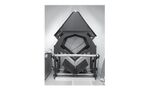User:Simon/Scanning: Difference between revisions
| Line 1: | Line 1: | ||
= scanning = | = scanning = | ||
[[File:XPUB bookscanner.jpeg|150px|thumb|An archivist bookscanner]] | |||
see also [[User:Simon/Human reading|human reading]], [[User:Simon/Machine reading|machine reading]] | see also [[User:Simon/Human reading|human reading]], [[User:Simon/Machine reading|machine reading]] | ||
Revision as of 16:38, 5 June 2020
scanning
see also human reading, machine reading
Scanning is reading for particular details (such as names and numbers) by running one’s eyes over every word in a line. Sometimes I find myself using my index finger to guide my eyes when scanning a printed text. With a computer and full-text search capabilities, control-f helps find instances of a particular word or phrase.
Scanning is also a way to process printed matter so that it may be electronically archived, modified and distributed. A bookscanner is the tool of choice for many archivists. It has two cameras, one to capture the odd pages, and one for the even pages. Most bookscanners consist of a system of pulleys which allow the book to be raised to two perpendicular sheets of glass, laying the pages flat and ensuring the focus is correct. It’s quite a workout, and is usually reserved for books which are difficult to find in digital format. Essentially the bookscanner takes two photographs, one each for the even and odd sides of a spread. So the sequence goes; flip, click click, flip, click click, and so on, and so on. Next, these images must go through a variety of processes to produce a digital book; rotating, cropping to the size of the page, merging into a single PDF. Ultimately, the most useful digital books include a digital text layer generated by OCR (Optical Character Recognition) software, making the text searchable and copy/pasteable.
Image: An archivist bookscanner

